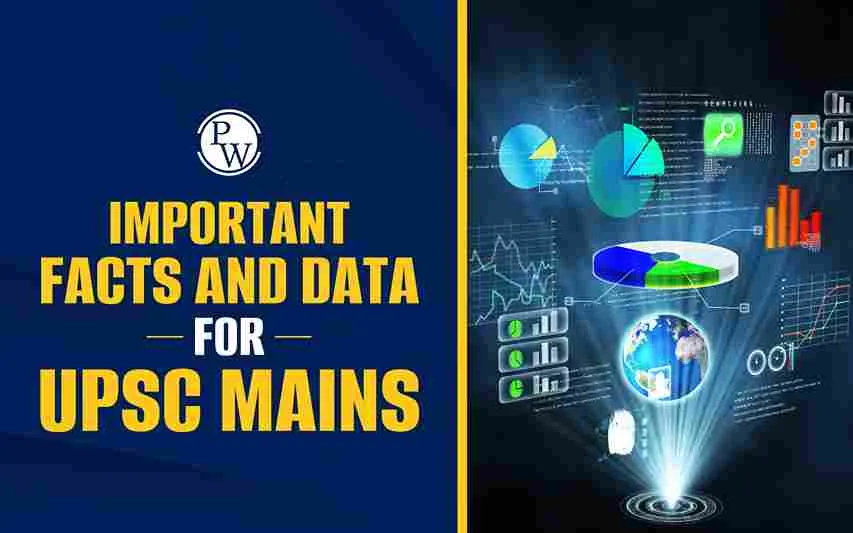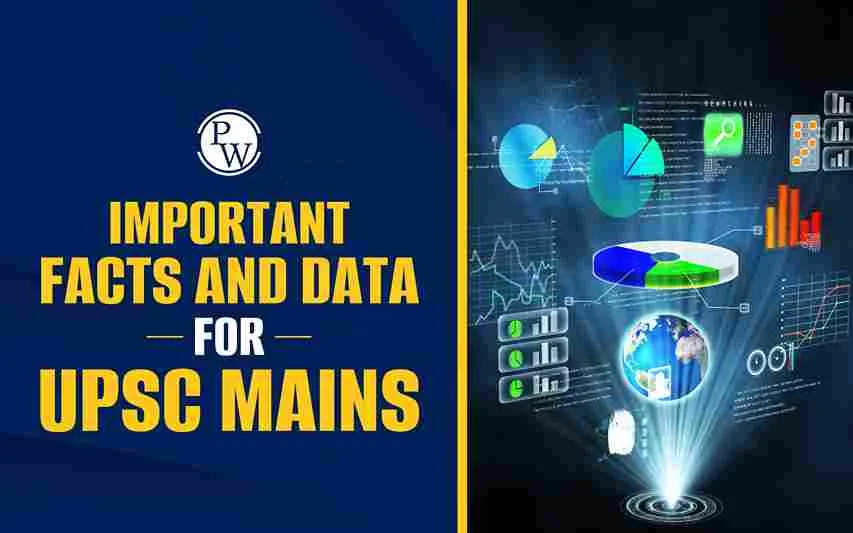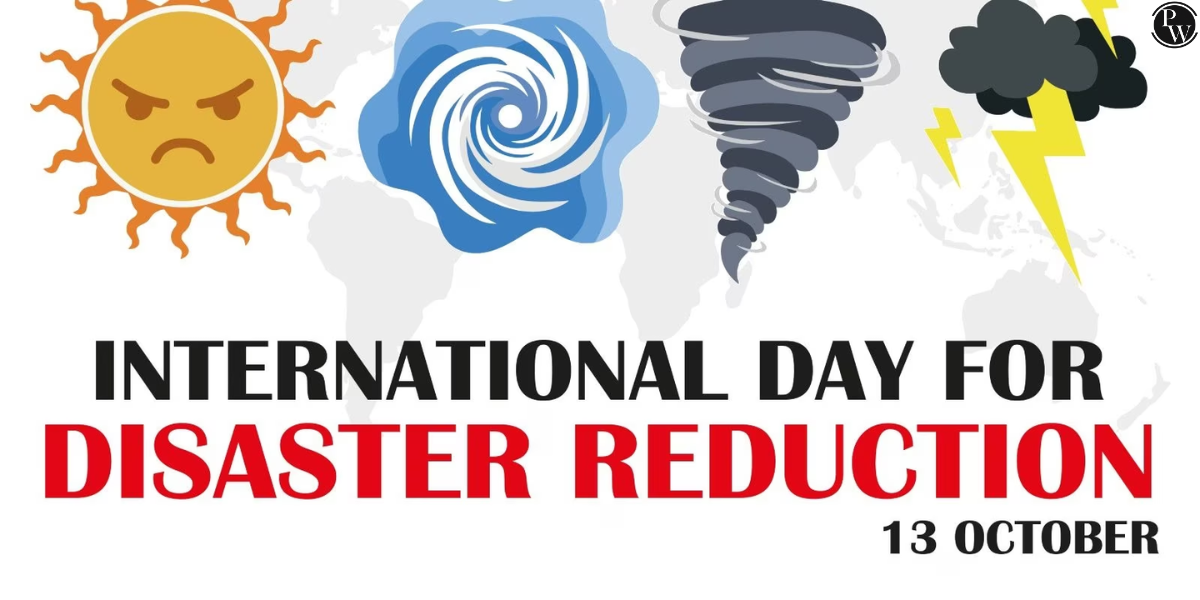

Important Facts and Data for UPSC Mains 2025: In the UPSC Mains, the data and facts are useful tools to improve answers. By using accurate and relevant data and facts for UPSC Mains 2025, candidates can substantiate their arguments, demonstrate a deep understanding of topics, and provide concrete examples that enhance their analysis.
The use of facts and data for UPSC Mains showcases the candidate’s understanding of current issues and ability to critically analyze various dimensions of a topic. Read on to get UPSC Mains key data across various sections that will help you excel in your preparation, and download the important facts and data for UPSC Mains 2025 for revision.Society and Social Issues Data for UPSC Mains 2025
fSociety and social issues are crucial subjects in UPSC Mains GS 1 and GS 2 papers. The figures below illustrate the diversity and challenges within Indian society, crucial for your UPSC Mains 2025 preparation.| Important Data for UPSC Mains on Society and Social Issues | |
| Tribes in India |
|
| India as a Multilingual Society |
|
| Women |
|
| Children |
|
| Population and Associated Issues |
|
| Important Schemes |
|
Polity and Governance Data for UPSC Mains 2025
Polity and governance are central to the UPSC Mains GS 2 syllabus. Knowing UPSC Mains factual information on issues related to polity and governance will help you understand the effectiveness and challenges of governance in India.| Polity and Governance Data for UPSC Mains 2025 | |
| Governance |
|
| E-Governance |
|
| Judiciary |
|
| Parliament and Legislatures of UTs and States |
|
| Prison Reforms |
|
| Schemes for Good Governance |
|
Economy and Development Data for UPSC Mains 2025
UPSC Mains exam facts in Union Budget 2025, Economic Survey 2025, and other documents on Economics are vital for answering questions on growth and development. These statistics are key to discussing economic trends and policies in your UPSC Mains 2025 answers.| Important Data for UPSC Mains 2025 on Economy and Development | |
| Economic Growth |
|
| Employment, Unemployment, and Skill Development |
|
| Taxation |
|
| Inclusive Growth |
|
| Agriculture |
|
| Industry and Infrastructure |
|
Environment Data for UPSC Mains 2025
Environmental issues are increasingly important in UPSC exams. A grasp of data related to environment and ecology is essential to answer GS 3 questions. Such data highlight the environmental challenges and conservation efforts needed in India.| Important Environment Data for UPSC Mains 2025 | |
| Indian Biodiversity |
|
| Wildlife |
|
| Forest Conservation |
|
| Water Resources |
|
| Water Pollution |
|
| Climate Change |
|
Science and Technology Data for UPSC Mains 2025
Science and technology advancements play a crucial role in national development. This topic forms an integral part of the GS 3 paper. Further, candidates may also face an Essay topic related to Science and Technology. This data will help you discuss India's technological progress and challenges.| Science and Technology Data for UPSC Mains 2025 | |
| Intellectual Property and Patent | India has improved its overall International Intellectual Property (IIP) score from 38.4% to 3 8.6%. (IIPI 2022). |
| Artificial Intelligence | Al has the potential to add around $1 trillion to India's economy and boost India's annual growth rate by 1.3% by 2035. (NITI Aayog) |
| Information and Communication Technology |
|
| Research and Development | India is now placed at 40th position among the top innovative economies. (Global Innovation Index 2022) |
| Space Technology |
|
Data for UPSC Mains 2025: Internal Security
Internal Security is a critical aspect of the GS 3 paper. The statistics below provide a clear picture of the improvements and ongoing challenges in India's security landscape. Candidates can use these UPSC Mains exam facts on internal security to make their answers better:| Data for UPSC Mains 2025: Internal Security | |
| Left-Wing Extremism |
|
| Insurgency in North East | Reduced by 80% in the last eight years while casualties of security forces went down by 75% and civilian deaths by 99%. |
| Terrorism | India ranked 13th in the Global Terrorism Index (GTI) 2023. |
| Cyber Security |
|
| Money Laundering | According to the IMF, the amount of money laundered globally in one year is 2 - 5% of global GDP. |
Data for UPSC Mains 2025: Disaster Management
Answering questions in the Disaster Management section requires understanding the risks and preparedness. The data given below is essential for discussing disaster preparedness and response strategies in your UPSC Mains exam.| Disaster Management Data for UPSC Mains 2025 | |
| Earthquake |
|
| Cyclone |
|
| Flood |
|
| Drought |
|
| Climate Refugee | India had around 50 lakh internal displacements caused by disasters and extreme weather conditions like floods, cyclones, and drought in 2019. (‘State of India's Environment 2020 in Figures) |
| Landslides |
|
How to Use Facts and Data in UPSC Mains 2025?
Using data effectively in your UPSC Mains 2025 answers can greatly strengthen your arguments making them more credible. Here’s how to integrate data into your UPSC Mains answers:- Identify Relevant Data: Focus on key statistics, facts, and examples related to current affairs, historical contexts, and syllabus topics. To ensure the data is accurate and recent refer to PW OnlyIAS Prahaar Mains Booklet 2025.
- Illustrate Trends and Support Analysis: Use data to highlight trends, back up your analysis, and provide solid evidence for your points.
- Present Data Clearly: Use bullet points and underline the facts, enhancing readability and making your answers more impactful.
- Relate Data in Questions: Connect the data to broader themes of questions, such as socio-economic or political implications. This shows your ability to think critically and apply knowledge to real-life situations.
- Cite Sources: Mention the source of your data, such as 'according to the NITI Aayog report' when using data in an answer. This not only adds credibility but also demonstrates thorough research.
Important Facts and Data for UPSC Mains 2025 FAQs
What are the most important current affairs for UPSC Mains 2025?
The most important current affairs for UPSC Mains 2025 include updates on governance, economy, social issues, environment, science and technology, and international relations.
Is it necessary to use facts and data in UPSC Mains 2025?
Yes, using facts and data in UPSC Mains 2025 is necessary to substantiate your arguments and add credibility to your answers.
How to effectively use data in UPSC Mains answers?
Effectively use data in UPSC Mains answers by integrating relevant statistics to support your points, ensuring accuracy, and citing credible sources.
Which is the best source for UPSC Mains facts and data?
The best sources for UPSC Mains facts and data are government reports, economic surveys, UN reports, and PW OnlyIAS Prahaar Mains Booklets.
How can I make my answers stand out in the UPSC Mains 2025 exam?
To make your answers stand out in the UPSC Mains exam, focus on incorporating relevant facts, data, examples, and current affairs while maintaining a clear structure and precise language.
Talk to a counsellorHave doubts? Our support team will be happy to assist you!

Check out these Related Articles
Free Learning Resources
PW Books
Notes (Class 10-12)
PW Study Materials
Notes (Class 6-9)
Ncert Solutions
Govt Exams
Class 6th to 12th Online Courses
Govt Job Exams Courses
UPSC Coaching
Defence Exam Coaching
Gate Exam Coaching
Other Exams
Know about Physics Wallah
Physics Wallah is an Indian edtech platform that provides accessible & comprehensive learning experiences to students from Class 6th to postgraduate level. We also provide extensive NCERT solutions, sample paper, NEET, JEE Mains, BITSAT previous year papers & more such resources to students. Physics Wallah also caters to over 3.5 million registered students and over 78 lakh+ Youtube subscribers with 4.8 rating on its app.
We Stand Out because
We provide students with intensive courses with India’s qualified & experienced faculties & mentors. PW strives to make the learning experience comprehensive and accessible for students of all sections of society. We believe in empowering every single student who couldn't dream of a good career in engineering and medical field earlier.
Our Key Focus Areas
Physics Wallah's main focus is to make the learning experience as economical as possible for all students. With our affordable courses like Lakshya, Udaan and Arjuna and many others, we have been able to provide a platform for lakhs of aspirants. From providing Chemistry, Maths, Physics formula to giving e-books of eminent authors like RD Sharma, RS Aggarwal and Lakhmir Singh, PW focuses on every single student's need for preparation.
What Makes Us Different
Physics Wallah strives to develop a comprehensive pedagogical structure for students, where they get a state-of-the-art learning experience with study material and resources. Apart from catering students preparing for JEE Mains and NEET, PW also provides study material for each state board like Uttar Pradesh, Bihar, and others
Copyright © 2025 Physicswallah Limited All rights reserved.












